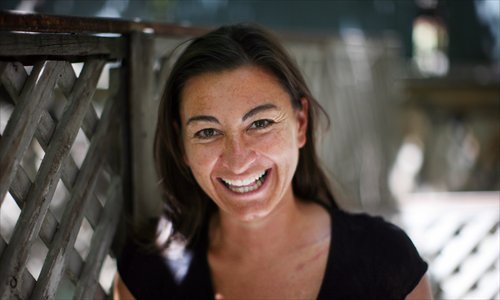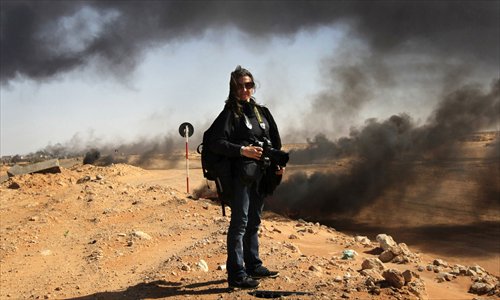HOME >> ARTS
The woman at center of new Spielberg film
Source:AFP Published: 2016-4-10 19:08:01

Lynsey Addario Photo: CFP

Addario stands near the frontline during a pause in the fighting on March 11, 2011 in Ras Lanuf, Libya. Photo: AFP
Her parents were hairdressers in a small town in Connecticut - so it wasn't exactly written in the stars that Lynsey Addario should become one of the world's best known war photographers.Even after her Italian-American family got her a Nikon camera for her 13th birthday, she thought "photographers were crazy rich kids" with time on their hands.
But fate was about to deal Addario the first of many strange hands that would take her to Afghanistan before September 11 turned the world upside down, and then from one war zone to the next.
"I never set out or wanted to cover war," the 42-year-old, who has continued to cover conflicts since becoming a mother five years ago, told AFP.
In her book, It's What I Do, Addario tries to make sense of what got her into one of the world's most dangerous professions.
Despite several scrapes with death documenting wars from Iraq to Congo, "I didn't think anyone would read the book," she said.
"It felt really uncomfortable... egotistical (even). I thought, who would possibly care about my life?"
Steven Spielberg for starters. He is about to tell her story in a new film in which she will be played by Hunger Games star Jennifer Lawrence.
Taken hostage
It will center on her kidnapping in Libya in March 2011, when she was held with four other New York Times journalists by soldiers loyal to Colonel Kadhafi as large parts of the country rose up against him.
That nightmare which included beatings, death threats and Addario being molested by her captors, ended with the journalists being released after a few days.
Their driver Mohammed, who had been "frantic" with fear as they lingered amid sniper fire to photograph rebels along the road to the besieged town of Ajdabiya, was not so fortunate.
"I didn't want to be the cowardly photographer or the terrified girl who prevented the men from doing their work," Addario wrote later, questioning their actions.
As they were taken away, Mohammed was shot by the roadside.
It was his death, and that of her friends and fellow photographers Tim Hetherington and Chris Hondros who were killed in Kadhafi's hometown Misrata the following month, that pushed Addario to put pen to paper.
"After I was released I wanted to do a photo book. I was thinking about the work I had done, and going through my old work, and it was then that I found out that Tim and Chris had been killed," she said.
"I had this sort of moment of reckoning. I wanted to write... to communicate what I went through in Libya after my friends were killed. It just seemed a better way."
As she tells it, Addario - who won a Pulitzer prize as part of a New York Times team in 2009 - is an accidental war photographer.
It all began after she was sent to Afghanistan in 2000 to photograph life for women under the Taliban. The following year, a country which most Americans could not have found on the map, became a national obsession as the hunt began for Osama bin Laden.
"I never set out or wanted to cover war. I started it because I'd been working so much in Afghanistan on the Taliban. It was natural that I went back there.
"Then I wanted to be in Iraq so I started to cover wars regularly, but it was because the stories brought me there, not because of war itself."
Tea with the Al-Zarqawis
It was in Iraq where she met the sisters of the then leader of Al-Qaeda in Iraq, Abu Musab Al-Zarqawi, out of whose group the Islamic State grew.
"I do think it's always been a great advantage being a woman in this job," she told AFP during a visit to Paris, where her book has just been published in French.
"But because I work in the Muslim world I have access to both women and men. I can go into people's houses and interview the mothers and the sisters," she said.
"I had tea with Al-Zarqawi's sisters because I was a woman, so I was thrown in with the women!"
Despite having a 5-year-old son, Lukas, to whom she dedicated her book, Addario has continued to go work in war zones.
"I want people to see how other people live and to be sort of a messenger, I want to connect the dots, to give people perspective."
For her the choice is simple.
"When I'm covering a humanitarian crisis, human rights abuse or war... you have to be out there (for it) to be seen by people from the comfort of their home."
Newspaper headline: War photographer and mother
Posted in: Film